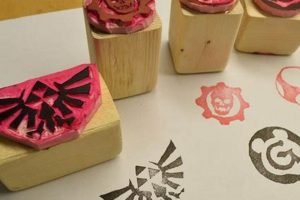A constructed platform designed to simulate the elevated area from which a baseball pitcher delivers pitches is a fundamental element for baseball training. This elevated space provides a consistent height and slope, enabling pitchers to develop proper mechanics and improve performance outside of a regulation baseball field. An example of its utilization would be a baseball team creating one for their practice field.
The creation of such a structure allows for accessibility to focused pitching practice, improving individual skills and team performance. Its use can be traced back to the standardization of baseball field dimensions, and it continues to be integral in developing pitching talent at various levels. The advantages include convenience, cost savings compared to professional installations, and customization to specific training needs.
The subsequent sections will detail various construction methods, material considerations, safety precautions, and maintenance guidelines for creating a durable and effective platform. This will enable individuals to design and build a structure tailored to their specific requirements and available resources.
Construction Tips for Elevated Pitching Platforms
The following guidelines offer essential considerations for constructing a durable and effective elevated pitching area. Adherence to these recommendations will contribute to both the longevity and safety of the structure.
Tip 1: Foundation Stability: Ensure a solid and level base. Compacting the ground and using a crushed stone layer prior to construction mitigates settling and provides a stable foundation. Failure to adequately prepare the foundation can lead to uneven surfaces and premature structural failure.
Tip 2: Gradual Slope Implementation: A consistent and gradual slope is vital. The standard incline is one inch per foot. Employing a level and measuring carefully during construction will help achieve the appropriate angle for accurate pitching mechanics.
Tip 3: Durable Material Selection: Choose weather-resistant materials. Pressure-treated lumber, all-weather turf, and exterior-grade fasteners are recommended for long-term durability and resistance to the elements. Untreated materials will degrade rapidly, necessitating frequent repairs or replacement.
Tip 4: Secure Fastening Techniques: Use appropriate fastening methods. Screws provide greater holding power compared to nails, especially when dealing with fluctuating weather conditions. Predrilling holes will prevent splitting of the wood during assembly.
Tip 5: Adequate Drainage System: Proper drainage is essential. Incorporating a slight pitch to the sides allows water to run off, preventing waterlogging and potential damage to the structure’s core. This reduces the likelihood of rot and extends the life of the material.
Tip 6: Safety Considerations: Prioritize safety measures. Rounded edges, non-slip surfaces, and clearly marked boundaries will reduce the risk of injury. Regular inspections for splinters, loose screws, or damaged turf are crucial for maintaining a safe training environment.
Tip 7: Turf Installation: Ensure a smooth and secure turf installation. Using adhesive specifically designed for artificial turf will prevent bubbling or lifting, creating a consistent and professional surface for pitching. Uneven turf can lead to inaccurate pitching and potential injury.
By implementing these guidelines during construction, a safe, durable, and effective elevated platform can be achieved, facilitating optimal pitching practice.
The following section will cover maintenance and upkeep procedures to ensure its longevity and continued performance.
1. Stability
Stability is paramount in the construction and use of a constructed pitching platform, directly influencing the consistency of practice and the prevention of injuries. A lack of stability compromises the structural integrity of the platform and the efficacy of training.
- Foundation Integrity
The foundation serves as the load-bearing element. A properly compacted and level foundation, often utilizing crushed stone, prevents settling and shifting. A compromised foundation leads to uneven surfaces, affecting a pitcher’s balance and delivery. For example, a foundation built on unstable soil will likely lead to cracking and tilting over time.
- Material Rigidity
The materials used in construction must possess adequate rigidity to withstand repetitive impact and environmental stressors. Pressure-treated lumber and reinforced framing contribute to overall structural stability. Flexing or warping of materials disrupts the intended slope and dimensions, negatively impacting the training experience. A mound constructed with substandard lumber is prone to sagging under a pitchers weight.
- Joint Security
Secure joints and connections are critical for maintaining the structure’s form. The use of screws, rather than nails, in conjunction with construction adhesive ensures that components remain firmly attached under stress. Weak joints introduce points of failure, leading to instability and potential collapse. For instance, inadequate fastening of the pitching rubber can cause it to loosen, affecting pitch accuracy and potentially causing slips.
- Environmental Resistance
The structure must resist degradation from environmental factors such as moisture, temperature fluctuations, and UV exposure. Proper drainage and the use of weather-resistant materials contribute to long-term stability. Water infiltration and subsequent rot undermine the structures integrity, reducing its lifespan and increasing the risk of failure. A mound lacking proper drainage will quickly deteriorate in wet climates.
In conclusion, stability in a constructed pitching platform is not merely a desirable attribute but a fundamental requirement. The foundation, materials, joint security, and environmental resistance collectively ensure a stable surface for effective training. Any compromise in these facets can lead to diminished performance, increased risk of injury, and reduced longevity of the platform itself.
2. Consistent Slope
The consistent slope inherent in a pitching platform is essential for the development and maintenance of proper pitching mechanics. A standardized gradient, typically a one-inch rise per foot leading to the pitching rubber, allows pitchers to establish repeatable movements, leading to improved accuracy and velocity. Deviation from this consistent slope introduces variability, hindering the pitcher’s ability to develop a reliable delivery. This consistency is crucial regardless of whether the mound is professionally installed or constructed independently.
The construction of a pitching platform without adhering to a consistent slope can lead
to several detrimental effects. For example, if the slope is too steep, the pitcher may be forced to lean back during their delivery, reducing power and control. Conversely, an insufficient slope can cause the pitcher to throw flat, increasing the risk of injury to the arm and shoulder. Therefore, accurate measurement and careful implementation of the slope are critical during construction. The slope should be checked frequently as part of regular maintenance.
Ultimately, a consistent slope is indispensable to the functionality and effectiveness of a pitching platform. It directly impacts the pitcher’s ability to refine their technique and prevents the development of compensatory movements that can lead to injury. Therefore, builders of platforms must prioritize slope consistency, employing precise measurement tools and construction methods. This focus contributes to the long-term value of the platform as a training tool. Challenges in achieving this consistency can often be addressed through meticulous planning and careful execution.
3. Material Durability
Material durability is a defining factor in the lifespan and utility of any constructed pitching platform. The selection of appropriate materials directly impacts the structure’s resistance to environmental stressors, physical wear, and overall performance. Failure to prioritize material durability can result in premature degradation, compromising the platform’s safety and effectiveness.
- Wood Selection and Treatment
The choice of wood for framing and support structures is paramount. Pressure-treated lumber is essential for resisting rot and insect infestation, particularly in outdoor environments. Untreated lumber will rapidly decay, weakening the structure and posing a safety hazard. For example, using untreated pine for the frame can lead to structural failure within a few seasons, whereas pressure-treated lumber can last for decades with proper maintenance.
- Turf Quality and Composition
The artificial turf surface must withstand repeated foot traffic, exposure to sunlight, and varying weather conditions. High-quality turf with UV resistance and durable backing is critical. Inexpensive turf may fade, tear, or detach from the base, creating an uneven and potentially hazardous surface. Consider professional-grade turf designed for baseball fields, known for its resilience and realistic ball bounce.
- Fastener Corrosion Resistance
Screws, nails, and other fasteners must resist corrosion to maintain structural integrity. Galvanized or stainless steel fasteners are recommended for outdoor applications. Standard steel fasteners will rust, weakening the joints and potentially causing structural failure. A platform constructed with non-corrosion-resistant fasteners will require frequent repairs and may ultimately become unusable.
- Protective Coatings and Sealants
The application of protective coatings and sealants can significantly extend the lifespan of a constructed pitching platform. Waterproof sealants applied to wood surfaces prevent water penetration and subsequent rot. UV-resistant coatings protect the turf from fading and degradation. These preventative measures enhance the platform’s resistance to environmental stressors and reduce the need for costly repairs.
The durability of materials used in platform construction directly affects its long-term value and safety. Investing in high-quality, weather-resistant materials and applying appropriate protective measures can significantly extend the platform’s lifespan, ensuring consistent performance and minimizing the risk of accidents. The initial cost savings associated with lower-quality materials are often outweighed by the increased maintenance requirements and reduced longevity, making material durability a critical consideration for any diy pitching mound project.
4. Safety Measures
The integration of rigorous safety measures is not merely a desirable addition but a fundamental requirement in the construction and utilization of any constructed pitching platform. These measures mitigate potential hazards associated with physical exertion, elevated surfaces, and projectile sports, directly influencing user well-being and minimizing the risk of injury.
- Surface Traction and Stability
Adequate surface traction is crucial for preventing slips and falls, particularly during dynamic pitching movements. Non-slip turf materials and secure fastening mechanisms are essential. An unstable or slick surface can lead to ankle sprains, knee injuries, and loss of control during the pitching motion. For instance, applying a textured coating to the platform’s surface significantly enhances grip, reducing the likelihood of accidents. Regular inspection and maintenance are necessary to preserve optimal traction.
- Edge Protection and Mitigation
Exposed edges present a tripping hazard and can cause lacerations upon impact. Rounded edges or protective edging materials effectively mitigate these risks. Sharp corners and abrupt transitions should be eliminated through careful design and construction. For example, installing rubber edging around the perimeter of the platform provides a cushioned barrier, minimizing the severity of potential injuries. A best practice is to chamfer all hard edges.
- Structural Integrity and Load Capacity
The platform’s structural integrity must withstand the dynamic forces exerted during pitching motions, including the pitcher’s weight and the impact of repeated foot strikes. Adequate framing, robust materials, and secure fasteners are necessary to prevent collapses or structural failures. Exceeding the platform’s load capacity or neglecting structural maintenance can lead to catastrophic incidents. Load testing during the initial construction phase is a reasonable precaution.
- Environmental Hazard Mitigation
Outdoor platforms must be designed to withstand environmental hazards such as water accumulation, UV exposure, and extreme temperatures. Proper drainage systems, weather-resistant materials, and UV-protective coatings are essential for preserving the platform’s structural integrity and preventing the formation of slippery surfaces. Neglecting environmental protection can lead to accelerated degradation, increased risk of fungal growth, and potential health hazards. Regular cleaning and maintenance are important considerations.
The multifaceted integration of these safety measures is intrinsic to the responsible design, construction, and use of a pitching platform. These measures collectively minimize the potential for accidents, safeguard user well-being, and contribute to the long-term utility and value of the structure. Compromising safety in pursuit of cost savings or expediency is an imprudent choice that can lead to significant consequences. By proactively implementing these precautions, a safer and more productive training environment is established.
5. Proper Dimensions
Adherence to prescribed dimensions is a fundamental aspect of a self-constructed pitching platform, directly influencing the
transferability of skills developed during practice to regulation baseball fields. Deviations from established standards can create discrepancies between training and actual game scenarios, potentially hindering a pitcher’s performance. The height, slope, and overall size of the platform must accurately replicate those of a professional mound to ensure consistent mechanics and prevent the development of detrimental habits. For instance, a platform that is significantly shorter than the standard height can lead to a flatter delivery, reducing velocity and increasing the risk of injury.
The slope, which governs the pitcher’s stride and delivery angle, is of particular importance. Baseball regulations dictate a gradual incline from the front to the back of the mound, typically one inch per foot. Incorrect slope measurements can disrupt the pitcher’s balance and timing, leading to inconsistent pitch placement and decreased effectiveness. Moreover, the overall area of the platform should provide sufficient space for the pitcher to move freely without feeling constricted. Insufficient space can affect the pitcher’s comfort and confidence, ultimately impacting their performance. Therefore, accurate measurement and replication of standard mound dimensions are essential for creating a functional and beneficial practice environment.
In summary, maintaining proper dimensions in the construction of a pitching platform is not merely a matter of aesthetics but a critical element in optimizing training outcomes. Accurate adherence to these dimensions promotes skill transferability, prevents the development of detrimental habits, and fosters a realistic practice environment. While the construction of such a platform offers cost-saving benefits and customized training opportunities, compromising on dimensional accuracy undermines its overall value. Therefore, those undertaking such projects should prioritize precision and attention to detail to ensure the platform serves its intended purpose effectively.
Frequently Asked Questions
The following questions address common inquiries and concerns regarding the construction and utilization of a self-made pitching platform. The responses aim to provide clear and concise information for individuals considering such a project.
Question 1: What are the essential tools required for building a suitable structure?
Essential tools include a circular saw, level, measuring tape, drill with various bits, hammer, safety glasses, and work gloves. The specific tools required may vary depending on the chosen construction method and materials.
Question 2: What is the recommended slope for an effective throwing surface?
The generally accepted slope is one inch of elevation gain per foot of length from the front edge of the platform to the pitching rubber. This gradual incline simulates the slope found on professional baseball fields.
Question 3: What materials are best suited for outdoor construction?
Pressure-treated lumber is recommended for the frame due to its resistance to rot and insects. Artificial turf designed for outdoor use provides a durable and weather-resistant surface. Galvanized or stainless-steel fasteners are crucial to prevent corrosion.
Question 4: How can stability during the pitching motion be guaranteed?
A solid and level foundation is essential. Compacting the ground and using a crushed stone base helps prevent settling. Securely fastening all components with screws and construction adhesive further enhances stability.
Question 5: What safety precautions should be taken during construction and use?
Wearing safety glasses and work gloves during construction is paramount. Rounded edges and non-slip surfaces reduce the risk of injuries. Regular inspections for loose screws, splinters, or damaged turf are necessary to maintain a safe environment.
Question 6: How does one maintain the pitching surface to ensure longevity?
Regular cleaning to remove dirt and debris is recommended. Repair any tears or damage to the turf promptly. Inspect the frame and fasteners periodically, replacing any worn or corroded components as needed. Proper drainage prevents water accumulation and prolongs the life of the structure.
Careful planning, appropriate materials, and adherence to safety guidelines are essential for the successful construction and long-term enjoyment of a self-built pitching platform.
The next section will explore advanced construction techniques for specialized training needs.
Concluding Remarks on Self-Constructed Pitching Platforms
This exploration of the diy pitching mound has emphasized the crucial elements of construction, encompassing material selection, dimensional accuracy, and safety protocols. Understanding the structural demands, environmental factors, and proper slope is paramount for creating a durable and effective training aid. Adherence to these tenets is essential for maximizing the utility and longevity of the platform.
The creation of a diy pitching mound represents a commitment to skill development and accessible training resources. By thoughtfully applying the principles outlined, individuals can construct a valuable asset, fostering improved pitching mechanics and a deeper engagement with the sport. Continued diligence in maintenance and adaptation will ensure the platform serves as a reliable training tool for years to come.







